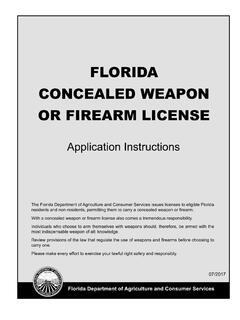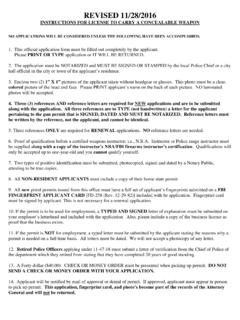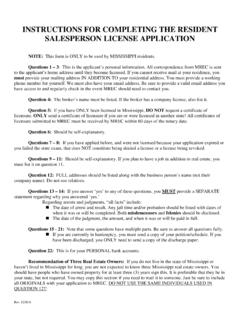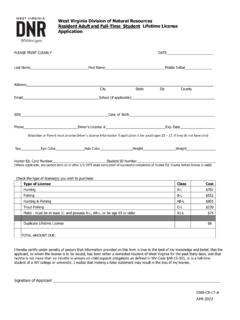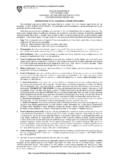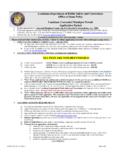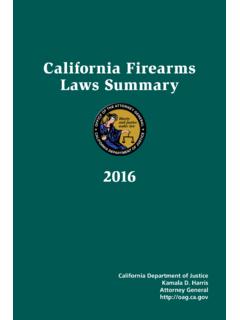Transcription of Safety at Street Works and Road Works - GOV.UK
1 Safety at Street Works and Road WorksA Code of PracticeOctober 20138815 Safety at Streetworks Cover 127/05/2014 10:48 Department for TransportGreat Minster House33 Horseferry RoadLondon SW1P 4 DRTelephone 0300 330 3000 Website enquiries Crown copyright, 2013 2nd impression (with amendments), June 2014 Copyright in the typographical arrangement rests with the may re-use this information (not including logos or third-party material) free of charge in any format or medium, under the terms of the Open Government Licence To view this licence, visit or e-mail Department for Transport would like to thank the following for their help in preparing this Code of Practice:The Department for Regional Development Northern IrelandThe Welsh GovernmentThe Scottish Government and the Scottish Road Works CommissionerHAUCNJUG LtdThe Health and Safety ExecutiveJAG(UK)Network Railand many other organisations and individuals who provided comments and 9780115531453 Printed in Great Britain on paper containing at least 75% recycled C200 06/148815 Safety at Streetworks Cover 227/05/2014 10.
2 48 Safety at Street Works and Road Works A Code of PracticeThis Code of Practice is issued by the Secretary of State for Transport and Welsh Ministers under section 65 of the New Roads and Street Works Act 1991 (NRSWA) and section 174 of the Highways Act 1980, by Scottish Ministers under section 124 of the NRSWA, and by the Department for Regional Development (Northern Ireland) under article 25 of the Street Works (Northern Ireland) Order 1995 and Article 31 of the Road Traffic Regulation Order (Northern Ireland) Safety at Streetworks 127/05/2014 10:37 2 ContentsKey questions 4 Foreword 5 Purpose of this Code of Practice 5 Application of the Code 5 Legal status of the Code 6 Other obligations not covered by this Code 7 Record keeping 7 Part 1: Basic principles 8 Using this Code 8 Responsibilities 9 Training and competence 9 Planning 10 Risk assessment 10 Part 2.
3 Operations 11 Before going to site 11 Works instructions 11 Equipment 11At the work site 12 Before you start 12 Arriving on site 15 Advance signing 16 Coned area 19 Information board 23 End sign 24 Variable message signs 24 Setting out the Works 25 Sequence for setting out signs 25 Footway and footpath Works look after pedestrians 28 Cycle routes look after cyclists 35 Equestrian routes look after horse riders 36 Carriageway Works 36 Works on single carriageway roads 36 Works on dual carriageways with a speed limit of 50 mph or more 40 Works on dual carriageways with a speed limit of 40 mph or less 40 Works at road junctions 43 Works at roundabouts 47 Works at pedestrian, cycle (Toucan) and equestrian crossings 50 Works in a bus lane 52 Traffic control 52 Traffic control near railway level crossings 56 Works at or near traffic signal controlled junction or pedestrian crossing 56 Traffic control by give and take 56 Traffic control by priority signs 588815 Safety at Streetworks 227/05/2014 10.
4 37 3 Traffic control by Stop/Go boards 60 Traffic control by portable traffic signals 62 Traffic control and speed reduction 67 Use of convoy working 68 Traffic control by road closure 70 Traffic control for temporary obstruction of the carriageway 72 Tramways and railways 74 Working near tramways 74 Works at or near railway level crossings 77 Works over and under railways 79 Works adjacent to railways 79 Checking and maintaining sites 81 Attended sites 81 Unattended sites (England, Wales and Northern Ireland) 81 Unattended sites (Scotland) 82 Removing the Works 83 Mobile Works and short-duration Works 83 Mobile Works 83 Short-duration Works 83 Risk assessment 86 Vehicle requirements 91 Signing 92 Part 3.
5 Equipment and vehicles 93 High visibility clothing 93 High visibility clothing (England and Northern Ireland) 93 High visibility clothing (Scotland and Wales) 93 Signs and cones 93 Warning lights 94 Pedestrian barriers 97 Pedestrian barriers (Scotland) 98 Footway ramps 98 Footway boards 99 Temporary covers over excavations 99 Road plates 99 Vehicles 100 Vehicles (England and Northern Ireland) 100 Vehicles (Scotland and Wales) 101 Glossar y 102 Index 103 List of figures 1048815 Safety at Streetworks 327/05/2014 10:37 4 Key questionsAsk yourself these questions:Will someone using the road or footway from any direction understand exactly what is happening and what is expected of them?
6 Have I made the site safe to work in and for the general public? 8815 Safety at Streetworks 427/05/2014 10:37 5 ForewordPurpose of this Code of PracticeThis Code of Practice (referred to from here on as the Code) is intended to help you to safely carry out signing, lighting and guarding of Street Works and road Works on all highways and roads, except motorways and any dual carriageways with a speed limit of 50 mph or more. This Code is directed at operatives, supervisors, managers, planners and designers who are responsible for making sure that all Street and road Works are safe for both operatives and the public. Road users including pedestrians, cyclists and equestrians (horse riders) should not be put at risk, and should be able to see the extent and nature of any obstruction well before they reach it.
7 You must pay particular attention to the needs of disabled people and should also consider other vulnerable groups such as elderly people, children and those with push chairs. This Code will help you to do : Failure to comply with this Code is evidence of failing to fulfil the legal requirements to sign, light and guard Works . Compliance with the Code will be taken as compliance with the legal requirements to which it : Further guidance on safe working on highways, including for some situations not covered by this Code, is available in Chapter 8 of the Traffic Signs Manual, published for the Department for Transport et al by The Stationery of the CodeThis Code applies to all highways and roads, except motorways and any dual carriageways with a speed limit of 50 mph or more.
8 This Code applies to Works carried out by or on behalf of both highway authorities and statutory undertakers. It does not cover skips and scaffolding placed in the Safety at Streetworks 527/05/2014 10:37 6 Guidance on some situations not covered by this Code can be found in Chapter 8 of the Traffic Signs Manual published for the Department for Transport et al by The Stationery Office. This gives authoritative advice, but it does not have the status of a Code of Practice under the Act. In Northern Ireland Article 31 of the Road Traffic Regulation Order (Northern Ireland) 1997 makes Chapter 8 mandatory for undertakers Works on motorways or any dual carriageways with a speed limit of 50 mph or more. Elsewhere in the United Kingdom undertakers should refer to Chapter 8 when carrying out such Works .
9 For other roads, Chapter 8 or other relevant documents may provide further applicable status of the CodeLocal highway authorities in England and Wales, and the road authority in Northern Ireland must comply with this Code for their own Works . Roads authorities in Scotland should comply with this Code for their own Works , as recommended by Scottish Ministers. All instances in the text of highway authorities are to be read as references to roads authorities in Scotland and Northern undertaker, and those working on its behalf, carrying out work under the New Roads and Street Works Act 1991 must comply with this Code for their own Works . With the exception of Scottish roads authorities, failure to comply with this Code is a criminal offence and may lead to criminal prosecution in addition to any civil proceedings.
10 Compliance with the Code will be taken as compliance with the legal requirements to which it Code is issued by the Secretary of State for Transport and Welsh Ministers under Section 65 of the New Roads and Street Works Act 1991 and Section 174 of the Highways Act 1980, by Scottish Ministers under Section 124 of the New Roads and Street Works Act 1991, and by the Department for Regional Development under article 25 of the Street Works (Northern Ireland) Order 1995 and Article 31 of the Road Traffic Regulation Order (Northern Ireland) instances in the text of TSRGD (TSR (NI) in Northern Ireland) are to be read as references to whatever versions of the Traffic Signs Regulations and General Directions or Traffic Signs Regulations (NI), as appropriate, are in force at the time.










